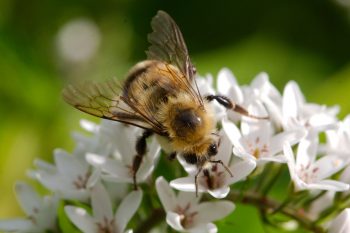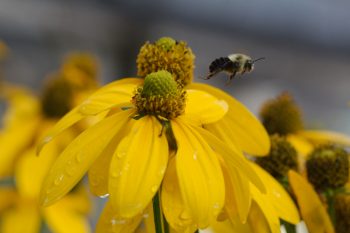We were out at Rocklands Farm to pick up our weekly share of produce and I enjoyed photographing crops. There are sunflowers growing in various places, mostly not yet fully in bloom. These, however, were beautiful. They are only about foot and a half tall but four or five inches across. The bumble bees (and many others) really seem to be happy about them. (Bombus griseocollis)
Tagged With: Bumble Bee
Bumble Bee on Sunflower
Bumble Bee Balm
I’ve been able to get a fair number of flower pictures so far this year but the insects are not out in all their force yet. I’ve seen many around but haven’t been able to photograph many of them. This is my first bumble bee of the summer. It isn’t the best bumble bee picture I’ve ever taken but it makes me happy, with the brightness of the bee balm (Monarda didyma) contrasting with the black of the common eastern bumble bee (Bombus impatiens). I’m sure there will be many more to come. As for the title of this post, it’s the sort of thing that shows up in crossword puzzles fairly often, two words or phrases that overlap in the middle. Bumble Bee and Bee Balm.
Monarda, Asclepias, and a Bombus
Along our back fence, the garden has really gotten out of control. With the work we’ve been doing on our mom’s houses, we haven’t really had time to give it half the attention it needs and deserves. Consequently, it’s got goldenrod, poke weed, and thistles growing in abundance. Three of our planted perennials are doing quite well, however, including the bee balm (Monarda didyma, also known as Oswego tea or bergamot) and the butterfly weed (Asclepias tuberosa) shown here. The other, not yet in bloom, is obedient plant (Physostegia virginiana). All three are native to the area and extremely tough. The bees love them and I followed this common eastern bumble bee (Bombus impatiens) for a while as he moved from flower to flower.
Bumble Bee on Coneflower
The coneflowers (Echinacea purpurea) in our yard tend to get eaten up by insects of one sort or another. I’m not sure who the culprit actually is, but they eat holes in the ray florets (the petals around the central group of disc florets), making the flowers a bit less attractive for photography. The bees aren’t bothered, of course, and this bumble bee (Bombus impatiens). The generic name Echinacea comes from the Greek word meaning hedgehog or sea-urchin, which references the spiny center of the flower. The name Bombus for bumble bees comes from the Latin (which took it from the Greek) for “booming, buzzing, humming.”
Eastern Bumble Bee
I went out looking for pictures as usual this afternoon, when I got home from work. There is Campanula in bloom in the yard, and I took some pictures of those flowers. They don’t tend to come out the same color in photographs as they are in real life. Not entirely sure why. Then I moved over to the gooseneck loosestrife (Lysimachia clethroides), which is a real attraction to the bees. It’s quite invasive and I really would recommend against planting it in the strongest language, but if you already have it, you might as well enjoy the bees. There were a few honey bees but mostly it was the common eastern bumble bees (Bombus impatiens) that were moving quickly from flower to flower.
Bombus impatiens (Common Eastern Bumble Bee)
Who doesn’t love the humble bumble bee? They are everywhere and like many of us, they are not particularly flashy or flamboyant. Nevertheless, they busily go about their business. I like them quite a bit and enjoy watching them move from flower to flower. In this case, a common eastern bumble bee (Bombus impatiens) is on wingstem, also known as yellow ironweed (Verbesina alternifolia). There were also honey bees (Apis mellifera) and ailanthus webworm moths (Atteva aurea) on the same group of flowers. It had become quite hot again, with temperatures in the low 90s, and I’m starting to look forward to autumn.
Bumble Bee on Lavender
I sat in the middle of the front garden this afternoon and took a few pictures. There were some bumble bees (Bombus impatiens, the common eastern bumble bee) moving from flower to flower and I waited for one to land on the lavender (this is a variety of Spanish lavender, Lavandula stoechas called ‘Anouk Supreme’). I only got four photos and none of them are quite what I was hoping for but this one isn’t too bad. When I’m in the yard, especially when it’s hot, I generally favor the shade but if I’m looking for photos, especially insect photos, the sun is the place to be.
Common Eastern Bumble Bee (Bombus impatiens)
Pretty much all the flowers in our garden are attractive to insects. I suppose that makes sense, because that’s what flowers are supposed to do, in order to get the insects to (inadvertently) pollinate the flowers. It’s interesting to me, though, that some flowers are attractive to many different insects but some seem to attract a specific subset. Yesterday, I was looking at the Monarda (bee balm) and noticed that the large bees were almost exclusively carpenter bees (Xylocopa virginica). Today I was looking at the gooseneck loosestrife (Lysimachia clethroides) shown here and the large bees were exclusively common eastern bumble bees (Bombus impatiens). Just interesting, that’s all.
On a mostly unrelated note, I really, really don’t recommend you plant any Lysimachia species in your garden. The bees love it, but there are other things they like that aren’t so overwhelming.
Busy As A…
Cathy and I went to Stadler Nursery late this morning. I bought a ninebark (Physocarpus opulifolius) called ‘Fireside’. It has very dark leaves which are a really lovely red early in the year and darken until they are nearly black in the late summer and fall. As usual I also took some flower photos. Getting an insect on the wing is not something I’ve had much success doing but this one turned out pretty well. It’s a common eastern bumble bee (Bombus impatiens) leaving a Rudbeckia ‘Herbstonne’ flower. We have a lot of Rudbeckia in our yard but most of it is one variety that is quite invasive. I wouldn’t mind thinning that out and replacing some with different types and this one is pretty nice.









